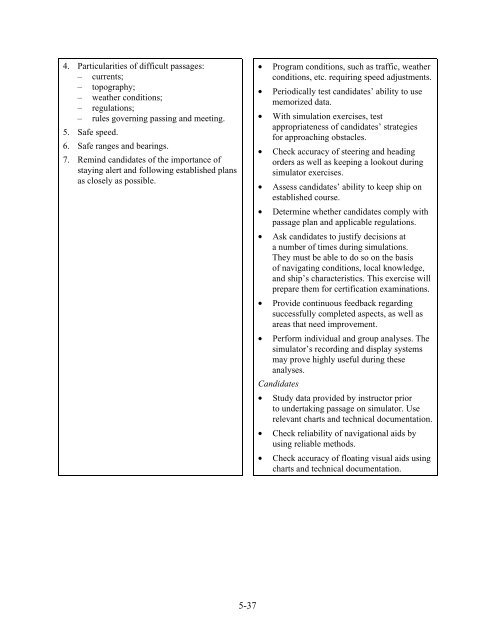District II Quebec City-Les Escoumins - Transports Canada
District II Quebec City-Les Escoumins - Transports Canada
District II Quebec City-Les Escoumins - Transports Canada
Create successful ePaper yourself
Turn your PDF publications into a flip-book with our unique Google optimized e-Paper software.
4. Particularities of difficult passages:<br />
– currents;<br />
– topography;<br />
– weather conditions;<br />
– regulations;<br />
– rules governing passing and meeting.<br />
5. Safe speed.<br />
6. Safe ranges and bearings.<br />
7. Remind candidates of the importance of<br />
staying alert and following established plans<br />
as closely as possible.<br />
• Program conditions, such as traffic, weather<br />
conditions, etc. requiring speed adjustments.<br />
• Periodically test candidates’ ability to use<br />
memorized data.<br />
• With simulation exercises, test<br />
appropriateness of candidates’ strategies<br />
for approaching obstacles.<br />
• Check accuracy of steering and heading<br />
orders as well as keeping a lookout during<br />
simulator exercises.<br />
• Assess candidates’ ability to keep ship on<br />
established course.<br />
• Determine whether candidates comply with<br />
passage plan and applicable regulations.<br />
• Ask candidates to justify decisions at<br />
a number of times during simulations.<br />
They must be able to do so on the basis<br />
of navigating conditions, local knowledge,<br />
and ship’s characteristics. This exercise will<br />
prepare them for certification examinations.<br />
• Provide continuous feedback regarding<br />
successfully completed aspects, as well as<br />
areas that need improvement.<br />
• Perform individual and group analyses. The<br />
simulator’s recording and display systems<br />
may prove highly useful during these<br />
analyses.<br />
Candidates<br />
• Study data provided by instructor prior<br />
to undertaking passage on simulator. Use<br />
relevant charts and technical documentation.<br />
• Check reliability of navigational aids by<br />
using reliable methods.<br />
• Check accuracy of floating visual aids using<br />
charts and technical documentation.<br />
5-37
















